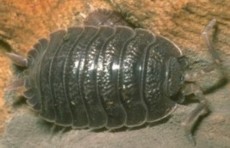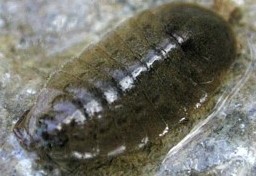|
|
ARTHROPODS:
Insects»
Spiders»
Centipedes»
Millipedes»
Sowbugs»
Harvestmen»
Mites
& Ticks»
Scorpions»
Identification
Tips»
About
the Critter Files»
Links» |
|
|
|
KENTUCKY
SOWBUGS
Critter
Files/Sowbugs
By
Blake Newton
University of Kentucky, Department of Entomology
| Common
Kentucky Sowbugs & Related Isopods: |
|
|
|
|
|
|
|
|
|
|
|
|
|
|
|
|
|
| |
| TAXONOMY |
KINGDOM: Animalia
| PHYLUM: Arthropoda | CLASS: Crustacea | ORDER: Isopoda (isopods)
Other
Names: roly-polies, woodlice, pillbugs, isopods |
| |
WHAT
IS A SOWBUG?
LIFE CYCLE
ECOLOGY
PEST STATUS
COMMON KENTUCKY SOWBUGS
COLLECTING & PHOTOGRAPHY
SOWBUG FACTS
MYTHS, LEGENDS, AND FOLKLORE |
| |
| WHAT
IS A SOWBUG? |
|
The Class Crustacea
includes many aquatic organisms (such as lobsters, shrimp, crabs,
and crayfish), but a few crustaceans are land-dwelling. Sowbug
is a name often used for land-dwelling crustaceans in
the order Isopoda. Also called "roly-polies"
and "woodlice" (among other names), sowbugs have many
body segments, 7 pairs of legs, and chewing mouthparts. Like
many crustaceans, sowbugs have 2 pairs of antennae, but 1 pair is
tiny and difficult to see without a microscope. Sowbugs resemble millipedes, but millipedes have 2 pairs
of legs on each body segment and only 1 pair of antennae. Sowbugs
breathe through plate-like gills located on the underside of the
abdomen.
Although the names "pillbug"
and "sowbug" are often used interchangeably, the name
"pillbug" is typically reserved for those isopods that can
roll themselves into a ball for protection from predators.
Many Kentucky isopods live in aquatic habitats. These aquatic isopod species are sometimes also called sowbugs and common ones look
very similar to terrestrial sowbugs and pillbugs. |
|
| SIZE:
Body length up to about 1/2", but usually less than 1/4"
for Kentucky sowbugs. |
| |
| LIFE
CYCLE |
|
Incomplete metamorphosis:
young pillbugs and sowbugs hatch from eggs and look just like the
adults, except smaller. They shed their skins as they grow.
Some sowbugs care for their young in water-filled pouches
on the underside of the body.
|
| |
| ECOLOGY |
|
Sowbugs are very common
in moist, cool conditions, and are often found under rocks and logs.
They feed on fungus and decaying plant material, usually moving
and feeding at night. Sowbugs are preyed upon by many creatures,
including spiders, centipedes, ground beetles, and small mammals.
Some sowbugs have foul-smelling, foul-tasting defensive chemicals
which provide some protection from predators. Pillbugs, of
course, are also able to roll themselves into a ball for protection. |
| |
| PEST
STATUS |
|
| Pillbugs and
sowbugs are beneficial decomposers of leaf litter and other decaying organic material. They are sometimes considered pests when they enter buildings, but they cannot hurt people and do not contaminate food or damage possessions.
For more information
about pillbugs and sowbugs as pests, read our EntFact: Pillbugs
and Sowbugs.
|
| |
COMMON
KENTUCKY SOWBUGS
And
Related Isopods |
|
|
SOWBUGS
AND PILLBUGS |
|
Kentucky has several
very common species of pillbugs and sowbugs. They are all similar
in appearance and behavior. Pictured below is an adult Sowbug
with an immature partially hidden underneath. As mentioned
above, pillbugs are able to roll into a ball, while other sowbugs
are not able to. |
| |
 Sowbug with Young
(Corel Photo CD 1993)
Sowbug with Young
(Corel Photo CD 1993) |
|
|
|
| AQUATIC
ISOPODS |
|
| Aquatic Isopods,
like the one pictured below, are very common under rocks and logs
in Kentucky streams and lakes. |
| |
 Aquatic Isopod
(B. Newton 2003)
Aquatic Isopod
(B. Newton 2003) |
|
| |
| COLLECTING
& PHOTOGRAPHY |
|
Pillbugs and sowbugs
are among the easiest arthropods to find and collect. Look
under logs or rocks in almost any kind of environment. They are
not easy to photograph, though: once uncovered, they almost never
stop moving (except to roll into a ball in the case of pillbugs).
They are best preserved in alcohol.
Pillbugs can also make
great pets! Read more about caring for them at Gordon's
Woodlice Care Sheet. |
| |
| SOWBUG
FACTS |
|
Although they resemble
tiny millipedes, pillbugs and sowbugs are actually crustaceans,
and are related to lobsters and crabs. In fact, terrestrial pillbugs and
sowbugs are among the few kinds of crustaceans that are able to
live on land.
The majority of species in the order Isopoda are aquatic. Many of them look very similar to terrestrial roly-polies and sowbugs, but
live in the deep ocean. Some of these are giants--big enough to
cook and eat like a lobster! Read more about giant marine isopods
in this article at Wikipedia:
http://en.wikipedia.org/wiki/Giant_isopod |
| |
| MYTHS
- LEGENDS - FOLKLORE |
|
In other parts of the
world, it is believed that eating pillbugs can help ease upset stomachs.
Although not proven, this might be true because pillbug shells
are high in calcium carbonate. |
| |
Original document: 25 May 2004
Last updated: 21 Apr 2008
Sowbug with Young
photo courtesy Corel Photo CD, 1993.
The Kentucky Critter
Files are maintained by Blake Newton, Department of Entomology, University
of Kentucky.
Contact: blaken@uky.edu |
|

